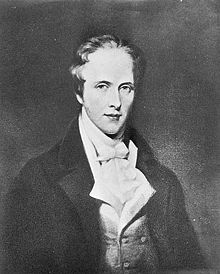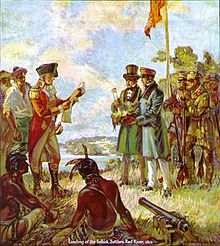- Thomas Douglas, 5th Earl of Selkirk
-
Thomas Douglas, 5th Earl of Selkirk (June 20, 1771 — April 8, 1820) was a Scottish peer. He was born at Saint Mary's Isle, Kirkcudbrightshire, Scotland. He was noteworthy as a Scottish philanthropist who sponsored immigrant settlements in Canada at the Red River Colony.
Contents
Early background
Douglas was the seventh son of Dunbar Douglas, 4th Earl of Selkirk, and Helen Hamilton. His early education was at the Palgrave Academy, Suffolk.[1] As he had not expected to inherit the family estate, he went to the University of Edinburgh to study to become a lawyer. While there, he noticed poor Scottish crofters who were being displaced by their landlords. Seeing their plight, he investigated ways he could help them find new land in the then British colonies. After his father's death in 1799, Douglas, the last surviving son (two brothers died in infancy, two died of tuberculosis and two died of yellow fever), became the 5th Earl of Selkirk. He established the Red River Colony in 1811 and brought dozens of families from the highlands of Scotland to transform the land at Red River into a farming colony. He helped poor people.
Involvement in Canada
When Thomas unexpectedly inherited the estate, he used his money and political connections to purchase land and settle poor Scottish farmers in Belfast, Prince Edward Island in 1803 and Upper Canada in 1804. He traveled extensively in North America, and his approach and work gained him some fame; in 1807 he was named Lord-Lieutenant of Kirkcudbright District in Scotland, and was elected a fellow of the Royal Society of London.
In order to continue his work re-settling Scottish farmers, Selkirk asked the British government for a land grant in the Red River Valley, a part of Rupert's Land. The government refused, as the Hudson's Bay Company (HBC) had been granted a fur trading monopoly on that land. However Selkirk was very determined, and he and Sir Alexander Mackenzie bought enough shares in HBC to let them gain control of the land. This position of power, along with his marriage connections (his wife Jean was the sister of Andrew Wedderburn, a member of the HBC governing committee) allowed him to acquire a land grant called Assiniboia to serve as an agricultural settlement for the company.
As part owner of HBC, Selkirk also wanted to stop the North West Company (NWC) from competing with the HBC for furs in the region. By placing the Red River Colony with the trade routes used by the NWC coureurs des bois, Selkirk could cut off the easy flow of furs. However, the local Métis people who already inhabited the area had long-standing ties with the NWC, and refused to accept Selkirk's control over the area.
The first colonization attempt started in 1812, consisting of 128 men led by the new governor, Miles Macdonell. Arriving late in the season they had just arrived and built homes when the winter cut off any hope of planting, and the colony became reliant on the support of the Métis. Even with a full growing season the next year, the colony never thrived. Because of a shortage of food in 1814, Macdonell issued the Pemmican Proclamation, prohibiting the export of food from the entire area. The Métis, who made a living selling Pemmican to the NWC traders, responded by arresting Macdonell and burning the settlement
Robert Semple was appointed as governor of the Red River Colony. By 1816, the violence intensified between the Métis and the newcomers, which resulted in the Battle of Seven Oaks, causing the deaths of 25 of Lord Selkirk's men, including the newly appointed governor.[2] NWC partners were accused of having aided the Métis attackers.
Selkirk and his men responded to the Battle of Seven Oaks by seizing Fort William, a trading post that belonged to the North West Company. In the aftermath, Selkirk was ordered to appear in court in Montreal and was charged with four separate offenses, all of which related to the alleged unlawful occupation of Fort William.[3] Selkirk reportedly spent most of his acquired fortune defending himself in court, shortly before his death.[4]
Legacy
Selkirk's colonizing ambitions have been memorialized in the names of the City of Selkirk and the Village of East Selkirk, as well as the Winnipeg neighborhood of Point Douglas (where Fort Douglas once stood) and Winnipeg's Selkirk Avenue. The City of Selkirk is served by the Lord Selkirk Regional Comprehensive Secondary School, which is administered by the Lord Selkirk School Division.
The Métis peoples cite Lord Selkirk's intrusion as the period in time their identity as a people came into existence. The Métis existed prior to the confrontations with Lord Selkirk's men but their armed resistance to foreign encroachment became a rallying point for their shared identity. A flag and a national anthem were born during this period in time.[5] A Manitoba Historical Plaque was erected in Winnipeg, Manitoba by the province to commemorate Thomas Douglas, 5th Earl of Selkirk's role in Manitoba's heritage.[6]
Selkirk and John Paul Jones
At the age of seven, Thomas, Master of Selkirk was almost kidnapped by John Paul Jones. Peter Newman tells the story as follows.[7]
In 1778, John Paul Jones, in the sloop Ranger was cruising between Scotland and Ireland looking for prizes. Benjamin Franklin had suggested that he might capture a British nobleman to exchange for American prisoners. Having been born near the Selkirk estates, Jones selected the elder Lord Selkirk.
At the last moment, Jones decided not to go himself, but to assign the duty to two lieutenants and a boatload of sailors. As the Americans approached the Selkirk mansion, a governess saw them coming and removed young Thomas to safety. The Americans knocked on the front door and were greeted by the butler. Lady Selkirk came from the breakfast room to see what the fuss was about. She invited the American officers into the drawing room, told the butler to make tea and to find some whiskey for the sailors who were waiting outside. When they explained that they has come to kidnap her husband, Lady Selkirk replied that unfortunately Lord Selkirk was not at home. When Lieutenant Wallingford suggested that instead they might take the young gentleman they saw on the way to the house, Lady Selkirk replied that they would have to kill her first. After more discussion Lady Selkirk suggested that, so that their mission would not be a complete failure, they might steal the family silver. The officers allowed as how that might be the best solution, so Lady Selkirk ordered the butler to provide the American gentlemen with what they needed. He filled a sack half full of coal, filled the top half with silverware and presented it to the officers. After drinking a toast to Lady Selkirk, they returned to their ship and presented their captain with his sack full of coal and silverware.
Jones wrote Lady Selkirk a flowery letter of apology, proposing himself to buy back the booty from the Navy and return it to the Selkirks. Lord Selkirk wrote back that he could not possibly countenance the return of his silver without the consent of the Continental Congress. The objects, which became the subject of protracted legal negotiations, were returned seven years later.
Works
- Observations on the present state of the Highlands of Scotland, with a view of the causes and probable consequences of emigration (London, 1805)
Further reading
- Bumsted, J. M.Lord Selkirk: A Life (University of Manitoba Press, 2008), 517pp, scholarly biography
References
- ^ The collected writings of Lord Selkirk 1799-1809. Manitoba Record Society. pp. 7. http://www.mhs.mb.ca/docs/books/mrs07.pdf.
- ^ R. Douglas Francis, Richard Jones, and Donald B. Smith. "Origins: Canadian History to Confederation", 4th ed. (Toronto:Harcourt Canada ltd., 2000), at p. 434-5.
- ^ Bryce, G., Life of Lord Selkirk, (1912), Toronto: The Musson Book Company, p. 81.
- ^ Henderson, A.M., (1968). "The Lord Selkirk Settlement at Red River, Part 2," Manitoba Pageant, 13(2), http://www.mhs.mb.ca/docs/pageant/13/selkirksettlement2.shtml.
- ^ Larry Chartrand. "The Definition of Metis Peoples in Section 35(2) of the Constitution Act, 1982. 67 Sask. L. Rev. 209 at p. 220-1.
- ^ Manitoba Plaque
- ^ Newman, Peter C., "The Empire of the Bay",Penguin,1998
- Phyllis A. Arnold Canada Revisited 8, Arnold Publishing Ltd.
External links
- Detailed biography at the Dictionary of Canadian Biography Online
- The Romantic Settlement of Lord Selkirk's Colonists at Project Gutenberg, by George Bryce 1909
- Peerage of Thomas Douglas
Honorary titles Preceded by
The 7th Earl of GallowayLord Lieutenant of Kirkcudbright
1807–1820Succeeded by
The 8th Earl of GallowayPeerage of Scotland Preceded by
Dunbar Douglas
Earl of Selkirk
1799–1820Succeeded by
Dunbar James DouglasCategories:- 1771 births
- 1820 deaths
- Earls in the Peerage of Scotland
- Fellows of the Royal Society
- Lord-Lieutenants of Kirkcudbright
- Red River Colony
- National Historic Persons of Canada
- People from Dumfries and Galloway
- Scottish philanthropists
- Alumni of the University of Edinburgh
- Scottish emigrants to pre-Confederation Canada
- Scottish political writers
- Scottish Gaelic-speaking people
- Scottish representative peers
Wikimedia Foundation. 2010.


